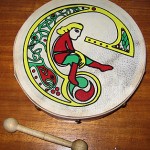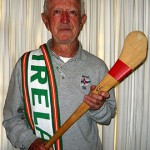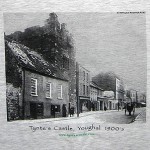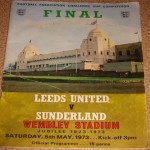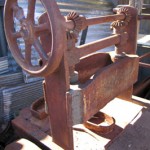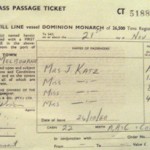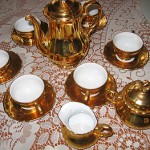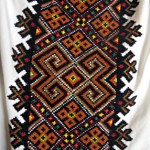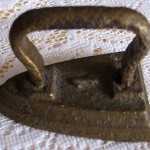Irish
Cork, Ireland
Southampton, England on 26 February 1958
Pyrmont, Sydney on 4 April 1958
Friend’s parents’ home in Bronte, Sydney’s eastern suburbs
Business Offset Services in Sydney CBD as a typesetter
Avis at North Sydney as a printer; various other printing jobs in Sydney suburbs; Mayor of Fairfield City Council in SW Sydney
I was born on 11 October 1927 in the city of Cork in the Republic of Ireland. My mother did not go out to work and sadly she died of septicaemia when I was only a year old. My father was killed in France in 1940 during World War Two when I was 13 years old and I was brought up by my mother’s parents.
I was reared in the town of Youghal, which was the home of Sir Walter Raleigh who had been [its] mayor. His importation of the potato to England from North Virginia in the USA has made quite a place in history. My grandfather had been in the British Army and was a saddle maker who later became a cobbler. I have a t-shirt from Ireland with a photograph of his cobbler shop and surrounding buildings on it. The little boy standing in front of the shop could well be me. It is one of the homes in which I lived. My grandparents both died when I was 14. From there I was shuffled around from one branch of the family to the other. The Youghal t-shirt tells part of my family history – it is a constant reminder of my youth and my former home.
At the age of 17 and a half I chose to join the [British] Royal Air Force (RAF). I went to Belfast [in Northern Ireland] to do that and an aunt needed to give permission as I was underage. I was accompanied by another local lad but as luck would have it, because of the initials of our surnames, we went through different doors at the recruiting office and I was never to see him again. He would make a career in the Air Force and became a squadron leader as I was to find out later.
My initial training was conducted at what was to become the infamous Long Kesh prison near Lisburn and about 14 kilometres from Belfast. On completion of it I was posted to England for the basic training. The place to which I was sent was Padgate, near Warrington in Lancashire, which had been an American base during the war. After a week or so they kitted us out and sent us to Leiston in Suffolk and there we spent eight weeks ‘square bashing,’ which was the name we gave to marching. I was an Aircraft Hand General Duties and the lowest form of animal life in the RAF. That was in 1946, the war being concluded the year before.
There were many old servicemen who had seen out the war and still did not know what to do with their lives, and then there were all of us newly recruited young men. The Labour Party [formed a majority government] for the first time ever when [Winston] Churchill had been deposed by the people and the country was near bankruptcy.
I had signed up with the RAF for five years, during which time I did a course in shorthand and typing at a civilian college in Newcastle-on-Tyne. After 13 weeks I was qualified and so began to serve at court martials. I did not need to have a particularly fast speed as military court officers were not practicing lawyers and so did not formulate their questions and statements at high speed.
I decided at the end of my contract that I would be demobilised and although I could have returned to the RAF later, I decided not to. I had friends in London and some relatives as well who found accommodation for me. Accommodation was very difficult to find at that time due to the fact that many areas had still not been rebuilt after the war. Some parts of London to this day have not been rebuilt.
I found accommodation and then sought work. My first job was at the Press Association in Fleet Street in the newspaper industry, where I remained for six or seven years. I worked as a telephone reporter while working at the Press Association. I would receive the news from the journalists by telephone, take it down in shorthand and type it directly to be subbed and then published. In summer I did sports reporting and amazingly much of it was cricket reporting which was strange for an Irishman. But it was good fun and I still like cricket.
At the end of six years a friend suggested that we go to Australia which was his home country, so I decided to go as a ‘Ten Pound Pom’. That meant that for the princely sum of ten pounds I had my fare paid by the Government with the condition that I remain in Australia for two years. I did not need a sponsor but if I returned to England before that time lapsed then I would have to repay my fare both ways. I also had to work, although there was no restriction on where I worked.
We sailed from Southampton on 26 February 1958 on Fairsea which was part of the Sitmar Line. They had made a lot of money transporting migrants to Australia and had three converted ships – Fairsky, Fairsea and Castel Felice. At first I had no feelings as I was about to leave for Australia, but I was young and had some money so I knew I could return to England should it not work out here. I felt positive about it though. I shared a dormitory on the ship with about ten others and our cabin was in the bowels of the ship. It was very hot and we perspired a lot. I still have friends from the ship and we met a few weeks ago to celebrate 50 years of being in Australia.
We left Southampton and went down the Bay of Biscay to the Straits of Gibraltar, into the Mediterranean Sea, through the Suez Canal and then to Aden. That part was lovely as the weather was warm and I needed that after leaving during England’s winter. We stopped a day in Aden for shopping but I did not purchase anything. There were something like 1,400 people on board, including about 400 children, and the passengers were mostly English, some Irish and Scots but a few other nationalities as well. The Scots proved to be the noisiest of all for some reason!
From there we set out for Fremantle which I thought was lovely. Here we spent a day only. The food onboard had not been too bad and we did not have buckets of pasta as they did on many of the other migrant ships, although it was an Italian ship.
We then sailed to Melbourne where we spent another day and where I saw my first television programs. It was black and white TV of course. The stores were highlighted with TVs and outside on the pavement there would be up to 50 people watching. It was a sight to remember.
We arrived in Pyrmont in Sydney at about noon on 4 April 1958, which was Good Friday. My first thought on arriving was that it was all so overwhelming. There were so many people on the wharf as we sailed in and that was a surprise to us – but we were soon to discover, that being Good Friday and Sydney hotels were not open, many had come just to drink in the ship’s bars. They were allowed onboard because they said that they were visiting relative passengers. Very Australian!
A friend was there to meet me and we went to the home of his parents who lived in a Housing Commission house in Hewlett Street, Bronte. The following day my friend’s father took me for a walk to the beach and I was once again overwhelmed with the sight of it. That day I was also introduced to Bob Brown who was a well-known rugby league footballer of the day.
From there we moved house to Collaroy, which was on the northern side of the harbour. I quickly found that there was a hotel in Newport and Dee Why, both not too far away from home. My friend and I were not getting on too well though so I decided to go it alone. I went to Kings Cross and then found a bedsitter at Potts Point. The atmosphere there was similar to that in which I had lived in London. I was not so very happy though and considered paying up and returning to England.
I had begun to work at Business Offset Services, which was a small offset printery in Bligh Street, Sydney. That was my first job in Australia. Once again I was ‘John all cotton’ for a couple of weeks but then went on to do legal copy work. The work was not the old fashioned letter press stuff but rather photo typesetting. I was happy there and remained for about six years but gradually became sick of their penny pinching and decided to move on.
My next position was at an art house, the name of which I can’t remember, but after about a year I wanted to move again. My next job was at Avis, the car company, at North Sydney and once again I was in printing. I was poached from there to another printing company and worked as a print salesman and I worked in that type of place until my retirement in about 1987.
In the meantime I had married a lady named Kaye and we moved to the Fairfield area. That was in 1962. Within a few years we had three children. I still live in the same house.
At about this time the Vietnam War was in progress and my feelings were so much against our involvement there that I began to take a very keen interest in politics. I joined the Smithfield Branch of the Labor Party and in 1972 was preselected for local elections. I was becoming very heavily involved [and] in 1990 I became Mayor of Fairfield City. In 1995 I left Council and I am no longer in the Labor Party as I did not agree with their methods of gerrymandering. I had 24 years of it and I wanted to do my own thing.
My main interest now is in Fairfield City Museum & Gallery where I do voluntary work. I also like to read a lot. I played golf for many years until my knee would no longer allow it and I also swim. I played the sport of hurling in Ireland and was never a great player but used to go to neighbouring counties to play in competitions. I brought this hurley stick from Ireland with me as a reminder of playing sport in Ireland. The hurley stick is Gaelic in origin and is similar in shape to a hockey stick. It is made of wood and now the participants in the game wear helmets as a precaution as the game is quite rough!
As well as sport, I travel whenever I can. I have a son in the USA who I visit periodically. My other two children are here and I have four grandchildren.
I have been in Australia for 50 years now and although I have been back to England and Ireland for holiday trips, I do not want to return to either to live. Very few of my contemporaries live there. They live in Australia or America or they have passed on. I have a bodhran, an Irish drum, which Kaye bought me in Westport in County Mayo. The side frame is made of wood and over it is stretched a skin of canvas on one side only which has been hand painted. It is attached to the frame with studs. The back of the instrument is hollow so that one’s hand sits in there and regulates the tone of the music. With it is the instrument with which the drum is played and it is also made of wood. The bodhran would be played in a band which would consist probably of a tin whistle and perhaps a fiddle and is a reminder of my Irish heritage.





